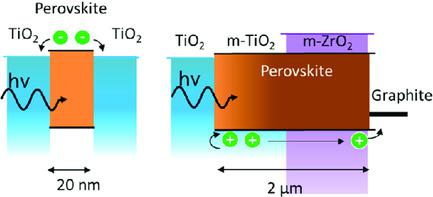Our official English website, www.x-mol.net, welcomes your feedback! (Note: you will need to create a separate account there.)
A 2D Model for Interfacial Recombination in Mesoscopic Perovskite Solar Cells with Printed Back Contact
Solar RRL ( IF 7.9 ) Pub Date : 2020-11-12 , DOI: 10.1002/solr.202000595 Lukas Wagner 1, 2 , Cheng Qiu 3 , Moritz Unmüssig 1, 4 , Dmitry Bogachuk 1 , Simone Mastroianni 1, 4 , Uli Würfel 1, 4 , Yue Hu 3 , Hongwei Han 3 , Andreas Hinsch 1
Solar RRL ( IF 7.9 ) Pub Date : 2020-11-12 , DOI: 10.1002/solr.202000595 Lukas Wagner 1, 2 , Cheng Qiu 3 , Moritz Unmüssig 1, 4 , Dmitry Bogachuk 1 , Simone Mastroianni 1, 4 , Uli Würfel 1, 4 , Yue Hu 3 , Hongwei Han 3 , Andreas Hinsch 1
Affiliation

|
A physical model to explain the 2D charge recombination in mesoscopic graphite‐based perovskite solar cells (PSCs) having a highly selective front electrode and a nonselective back electrode is presented. Steady‐state photovoltage and photoluminescence (PL) as well as transient PL are studied for a wide range of device configurations, providing insights in the interface recombination at the front and back contact, namely, the mesoporous titania (m‐TiO2) and the graphite layer. Combining experimental evidence with the first 2D simulation of a perovskite solar cell, it is found that the characteristic thick absorber layer of mesoscopic graphite‐based PSC is a necessity to enhance the photovoltage. This is because the interface recombination at the back contact is a diffusion‐limited process. The electrode spacing should, however, not be enhanced by increasing the perovskite/m‐TiO2 thickness as this increases surface recombination losses at this interface. The study determines design rules for the optimal geometry of the mesoporous layers and helps to identify the limiting recombination pathways for an improvement of future device architectures.
中文翻译:

具有印刷后接触的介观钙钛矿型太阳能电池界面复合的二维模型
提出了一种物理模型来解释具有高选择性前电极和非选择性后电极的介观石墨基钙钛矿太阳能电池(PSC)中的二维电荷复合。对稳态光电压和光致发光(PL)以及瞬态PL进行了广泛的器件配置研究,从而洞察了正面和背面接触的界面复合,即介孔二氧化钛(m-TiO 2)和石墨层。将实验证据与钙钛矿太阳能电池的第一个2D模拟相结合,发现介观石墨基PSC的特征性厚吸收层是增强光电压的必要条件。这是因为背面触点处的界面重组是扩散受限的过程。但是,不应通过增加钙钛矿/ m-TiO 2的厚度来增加电极间距,因为这会增加该界面处的表面复合损失。这项研究确定了介孔层最佳几何形状的设计规则,并有助于确定限制的重组途径,以改善未来的器件架构。
更新日期:2021-01-07
中文翻译:

具有印刷后接触的介观钙钛矿型太阳能电池界面复合的二维模型
提出了一种物理模型来解释具有高选择性前电极和非选择性后电极的介观石墨基钙钛矿太阳能电池(PSC)中的二维电荷复合。对稳态光电压和光致发光(PL)以及瞬态PL进行了广泛的器件配置研究,从而洞察了正面和背面接触的界面复合,即介孔二氧化钛(m-TiO 2)和石墨层。将实验证据与钙钛矿太阳能电池的第一个2D模拟相结合,发现介观石墨基PSC的特征性厚吸收层是增强光电压的必要条件。这是因为背面触点处的界面重组是扩散受限的过程。但是,不应通过增加钙钛矿/ m-TiO 2的厚度来增加电极间距,因为这会增加该界面处的表面复合损失。这项研究确定了介孔层最佳几何形状的设计规则,并有助于确定限制的重组途径,以改善未来的器件架构。



























 京公网安备 11010802027423号
京公网安备 11010802027423号